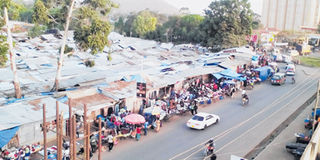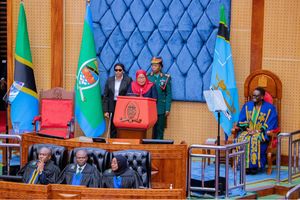SPECIAL REPORT : Arusha authorities in dilemma over hawker handling

The NMC hawkers’ market in Arusha City. The area, which in the past was used for holding political rallies, was set aside by local authorities to accommodate the ever increasing number of hawkers at the Arusha Main Market denying official traders an opportunity to trade while congesting the city centre streets.
PHOTO | Filbert Rweyemamu
What you need to know:
- Although Arusha city officials, led by politicians from the main Opposition party, Chadema, have refused to be drawn into an argument over the directive from the President, they have admitted that implementation of the order - either way - had quite some challenges and may not be that easy.
Arusha. An order issued by President John Magufuli some months ago, barring local leaders not to stop hawkers from undertaking their activities in urban centres has thrown Arusha authorities at a loss on what to do with hundreds of pedlars who have invaded even unauthorized areas.
Although Arusha city officials, led by politicians from the main Opposition party, Chadema, have refused to be drawn into an argument over the directive from the President, they have admitted that implementation of the order - either way - had quite some challenges and may not be that easy.
“We don’t have a problem on where to accommodate the machinga (hawkers) but they would often refuse to go to where we take them,” said city trade officer Godfrey Edward when he recently briefed The Citizen on various strategies being made to address the problem.
He said unlike in Mwanza where the Head of State was forced to order the authorities to review their relocation plans for the hawkers, the situation was slightly different in Arusha where the city authorities had earmarked some areas for resettling the pedlars operating within the central business district (CBD).
The exercise would certainly have to involve improving the facilities or expanding the markets in question located on the city periphery to enable them accommodate the new comers. Among the markets earmarked are Elerai, Ol Matejoo, Kijenge, Kilombero, Sanawari and Kwa Mrombo, among others.
However, implementation of the plans by city authorities to address the crisis and the actual situation on the ground are two different matters--not compatible at best.
This is more evident at the central market in the heart of Arusha City which is overwhelmed by hawkers who compete for customers with licensed traders who pay taxes and fees.
The Arusha central market, first opened in 1962 is a facility placed on a square of land between Somali, Azimio, Sokoni and Nyamwezi streets. In peak hours during week days it becomes a crowded lot.
The market and the surrounding area had its share of problems with the hawkers even before President Magufuli issued the directive on how to handle them during his visit to Mwanza late last year.
The hawkers were selling their items around it such that accessibility to the central market had become almost impossible. The streets leading to the market are so congested making it difficult for vehicles and pedestrians to access the market.
The city authorities, with the support of the then Arusha District Commissioner John Mongela (now Mwanza regional commissioner), decided that the National Milling Corporation (NMC) open ground which was used for political rallies be turned into a market where the growing number of hawkers would be re-settled.
The move paid off and soon the roads around the central market were cleared of the machinga who had been wooed to the ex-NMC ground.
Preference in space allocation was given to food vendors, including the women who travel each morning from the neighbouring Arumeru District with bunch of bananas on their heads.
But, according to one city official, the joy by the bonafide traders at the central market over the new found NMC grounds where the ‘bothersome’ hawkers who unfairly competed with them were sent, was short-lived.
“The machinga are very, very clever people who know well how to capitalise on the changing situations. They soon sold off their stalls at NMC and came back to the CBD to resume their hawking business around the central market,” one official told The Citizen on condition of anonymity because he is not the spokesperson of the city authority.
The city officials responsible for the central market were once again at a loss over how to address the recurring problem as the hawkers took over the market share of those licensed with shops and stalls inside the central market.
The dilemma here is that the market managers have no authority to chase the machinga from the streets surrounding the official markets after the directive from the Presidency. Likewise, they have no powers to stop the bona fide traders operating inside from venturing out to compete with the hawkers in the street pavements.
At the end of the day, according to Mr Edward, it was the city council which lost revenue. Due to ‘suffocation’ from the hawkers who literally ensured the buyers end with them first before getting inside, the bonafide traders operating inside the market could not make money to pay for the required fees.
In turn, it is feared, this would lead to declining revenues for the city council and the central government.
The 55 year old Arusha central market has six categories of traders licensed to operate within the confines of its area. These include ordinary shops and butcher shops which are 95, 29 fruits kiosks, 55 mini- shops, 97 vegetable stalls, 259 stalls for selling house utensils and allied merchandise and 957 iron tables for vegetable sellers.
The market fees range from Sh6,000 per month for vegetable sellers to Sh200,000 per month for shop operators. In all, it is expected to generate at least Sh32.6 million per month, the official explained, noting, however, that revenues are likely to decline with inability by licensed traders to maximize sales.




